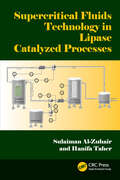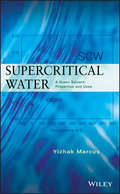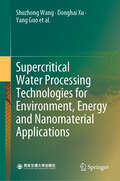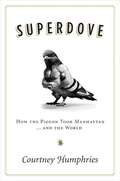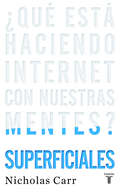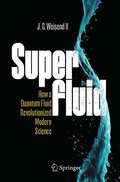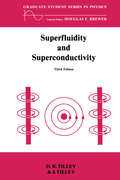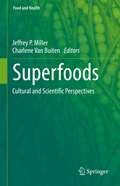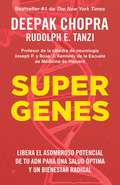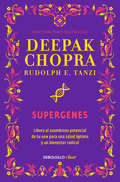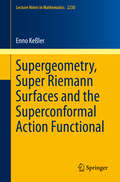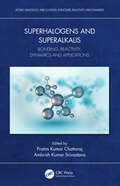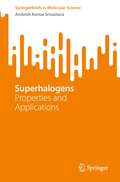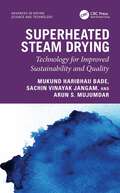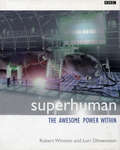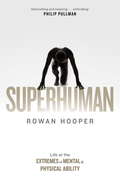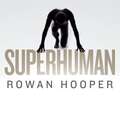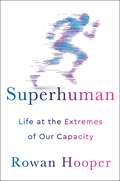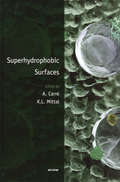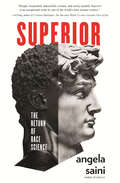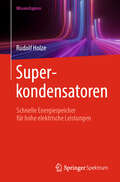- Table View
- List View
Supercritical Fluids Technology in Lipase Catalyzed Processes
by Sulaiman Al-Zuhair Hanifa TaherEnzymes are currently used in various industries, most commonly in food, detergents, and pharmaceuticals production. Lipases are hydrolytic enzymes that demonstrate great potential as an alternative to conventional catalysts in a number of industrial applications. A complete understanding of enzymes, and their proteins structure and environmental behavior, can greatly aid in the further development of industrial applications. Supercritical Fluids Technology in Lipase Catalized Processes provides basic information about enzymes, their sources, reaction kinetics, and main industrial applications. The book focuses in lipases. their main sources, structure, and features, with an emphasis on their specificity and interfacial activity, and presents proven techniques for isolating, extracting, and purifying. Comprised of six compact chapters, this comprehensive guide introduces: Immobilization techniques and immobilized lipases that allow repeated use (which is essential from an economic point of view) Different bioreactor configurations using immobilized lipases The latest information on the available technologies in lipolytic reactions The advantages of nonaqueous media in biochemical synthesis over aqueous and solvent-free systems Material on the use of lipases in nonaqueous media to overcome the drawbacks usually encountered with the use of conventional chemical catalysts The use of supercritical fluids (SCFs) as a green alternative reaction medium Factors affecting the physical properties of lipases in this medium and, hence, their activity and stability A case study using supercritical carbon dioxide (SC-CO2) for biodiesel production Novel, cutting-edge technology, using immobilized enzymes to reduce the overall production cost Supercritical Fluids Technology in Lipase Catalized Processes outlines the main industrial applications of common enzymes and discusses relevant challenges and innovations emerging in the field.
Supercritical Water
by Yizhak MarcusDiscover the many new and emerging applications of supercritical water as a green solventDrawing from thousands of original research articles, this book reviews and summarizes what is currently known about the properties and uses of supercritical water. In particular, it focuses on new and emerging applications of supercritical water as a green solvent, including the catalytic conversion of biomass into fuels and the oxidation of hazardous materials.Supercritical Water begins with an introduction that defines supercritical fluids in general. It then defines supercritical water in particular, using the saturation curve to illustrate its relationship to regular water. Following this introduction, the book: Describes the bulk macroscopic properties of supercritical water, using equations of state to explain temperature-pressure-density relationships Examines supercritical water's molecular properties, setting forth the latest experimental data as well as computer simulations that shed new light on structure and dynamics Explores the solubilities of gases, organic substances, salts, and ions in supercritical water in terms of the relevant phase equilibria Sets forth the practical uses of supercritical water at both small scales and full industrial scalesThroughout the book, the author uses tables for at-a-glance reviews of key information. Summaries at the end of each chapter reinforce core principles, and references to original research and reviews serve as a gateway and guide to the extensive literature in the field.Supercritical Water is written for students and professionals in physical chemistry, chemistry of water, chemical engineering, and organic chemistry, interested in exploring the applications and properties of supercritical water.
Supercritical Water Processing Technologies for Environment, Energy and Nanomaterial Applications
by Jie Zhang Shuzhong Wang Donghai Xu Yang Guo Xingying Tang Yuzhen Wang Honghe Ma Lili Qian Yanhui LiThis book systematically presents the technical aspects of supercritical water oxidation and supercritical water gasification for energy and environmental applications, which include reactor design, construction materials, corrosion, salt precipitation, etc. The book provides a comprehensive introduction to the properties of supercritical water, and the industrial applications, reaction mechanisms and reaction kinetics of supercritical water oxidation (SCWO) and supercritical water gasification (SCWG). The reactions occurring in supercritical water are complex, and studying their reaction mechanisms is of great importance for the development of supercritical water processing technologies. Accordingly, the book explains the oxidative mechanisms and kinetics of organic matter in supercritical water in detail. However, the harsh reaction conditions in supercritical water can easily create severe reactor corrosion and salt deposition problems. Therefore, the book also comprehensively reports on the mechanism analysis, state of research, and development trends regarding these two problems. Lastly, the book summarizes the development of supercritical water processing technologies, including studies on SCWO and SCWG, as well as near-zero-emission systems of pollutants based on SCWO technology. In short, the book provides a wealth of valuable information for all readers who are interested in using SCWO for organic waste treatment, and in using SCWG for hydrogen production with wet biomass.
Superdove: How the Pigeon Took Manhattan ... And the World
by Courtney HumphriesWhy do we see pigeons as lowly urban pests and how did they become such common city dwellers? Courtney Humphries traces the natural history of the pigeon, recounting how these shy birds that once made their homes on the sparse cliffs of sea coasts came to dominate our urban public spaces. While detailing this evolution, Humphries introduces us to synanthropy: The concept that animals can become dependent on humans without ceasing to be wild; they can adapt to the cityscape as if it were a field or a forest.Superdove simultaneously explores the pigeon's cultural transformation, from its life in the dovecotes of ancient Egypt to its service in the trenches of World War I, to its feats within the pigeon-racing societies of today. While the dove is traditionally recognized as a symbol of peace, the pigeon has long inspired a different sort of fetishistic devotion from breeders, eaters, and artists—and from those who recognized and exploited the pigeon's astounding abilities. Because of their fecundity, pigeons were symbols of fertility associated with Aphrodite, while their keen ability to find their way home made them ideal messengers and even pilots. Their usefulness largely forgotten, today's pigeons have become as ubiquitous and reviled as rats. But Superdove reveals something more surprising: By using pigeons for our own purposes, we humans have changed their evolution. And in doing so, we have helped make pigeons the ideal city dwellers they are today. In the tradition of Rats, the book that made its namesake rodents famous, Superdove is the fascinating story of the pigeon's journey from the wild to the city—the home they'll never leave.
Superficiales: ¿Qué está haciendo Internet con nuestras mentes?
by Nicholas Carr¿Qué está haciendo Internet con nuestras mentes? Este libro cambiará para siempre nuestro modo de entender y aprovechar las nuevas tecnologías. «¿Google nos vuelve estúpidos?» Nicholas Carr condensó así, en el título de un célebre artículo, uno de los debates más importantes de nuestro tiempo: mientras disfrutamos de las bondades de la Red, ¿estamos sacrificando nuestra capacidad para leer y pensar con profundidad? En este libro, Carr desarrolla sus argumentos para crear el más revelador análisis de las consecuencias intelectuales y culturales de Internet publicado hasta la fecha. Nuestro cerebro, como demuestran las evidencias científicas e históricas, cambia en respuesta a nuestras experiencias, y la tecnología que usamos para encontrar, almacenar y compartir información puede, literalmente, alterar nuestros procesos neuronales. Además, cada tecnología de la información conlleva una ética intelectual. Así como el libro impreso servía para centrar nuestra atención, fomentando el pensamiento profundo y creativo, Internet fomenta el picoteo rápido y distraído de pequeños fragmentos de información de muchas fuentes. Su ética es una ética industrial, de la velocidad y la eficiencia. La Red nos está reconfigurando a su propia imagen, volviéndonos más hábiles para manejar y ojear superficialmente la información pero menos capaces de concentración, contemplación y reflexión. Este libro cambiará para siempre nuestro modo de entender y aprovechar las nuevas tecnologías. Reseñas:«Absorbente y perturbador. Todos bromeamos sobre cómo Internet nos está convirtiendo, y especialmente a nuestros hijos, en cabezas de chorlito acelerados incapaces de meditaciones profundas. No es ninguna broma, insiste Carr, y a mí me ha convencido.»John Horgan, The Wall Street Journal «Una réplica calmada y elocuente a aquellos que afirman que la cultura digital es inofensiva, que afirman, de hecho, que nos estamos volviendo más listos cada minuto que pasa simplemente porque podemos conectarnos a un ordenador y dejarnos llevar por un interminable carrusel de links.»Julia Keller, Chicago Tribune
Superfluid States of Matter
by Boris V. Svistunov Egor S. Babaev Nikolay V. Prokof'evCovers the State of the Art in Superfluidity and SuperconductivitySuperfluid States of Matter addresses the phenomenon of superfluidity/superconductivity through an emergent, topologically protected constant of motion and covers topics developed over the past 20 years. The approach is based on the idea of separating universal classical-field superf
Superfluid: How a Quantum Fluid Revolutionized Modern Science
by J. G. Weisend IIUnless you are a specialist or watch a lot of obscure YouTube videos you have probably never heard of He II or superfluid helium. This substance, a unique liquid form of the element helium, is produced and used in multi-ton quantities to enable much of modern science. Altogether, He II is at the heart of more than a dozen large scale scientific facilities world-wide representing an investment of tens of billions of dollars. It cools the magnets and cavities that contain and accelerate the particle beams at the Large Hadron Collider and is also used in accelerators for the study of rare isotopes and nuclear astrophysics. This little known liquid is, in reality, one of the enabling technologies of the future. A manifestation of quantum mechanics, He II exhibits amazing behaviors. It can flow up the side of a container against gravity, it can move through small openings without friction, and it can transfer heat extremely efficiently via a mechanism not seen elsewhere in nature. This book tells the story of He II. It describes the discovery of the fluid, the observation and understanding of its behavior, the development of underlying theory and the evolution of He II from a laboratory curiosity to an industrial-scale coolant. The current and possible future applications of He II are described. Like all science and engineering, the story of He II is a human story and the role that personalities, politics, communication, cooperation and competition play in the development of He II is captured here as well. World-famous physicists such as Lev Landau, Richard Feynman, Peter Kapitza and Kurt Mendelssohn are key players in the story, while secret police from two different countries have a walk-on role. This work is meant for the general reader. Without assuming any expertise in physics, engineering or mathematics, it illuminates for the general public a little-known area of science and engineering and shows why it matters. As it turns out, it’s also a good story.
Superfluidity and Superconductivity (Graduate Student Series In Physics)
by D. R. TilleySuperfluidity and Superconductivity, Third Edition introduces the low-temperature phenomena of superfluidity and superconductivity from a unified viewpoint. The book stresses the existence of a macroscopic wave function as a central principle, presents an extensive discussion of macroscopic theories, and includes full descriptions of relevant experimental results throughout. This edition also features an additional chapter on high-temperature superconductors. With problems at the end of most chapters as well as the careful elaboration of basic principles, this comprehensive survey of experiment and theory provides an accessible and invaluable foundation for graduate students studying low-temperature physics as well as senior undergraduates taking specialized courses.
Superfoods: Cultural and Scientific Perspectives (Food and Health)
by Jeffrey P. Miller Charlene Van BuitenSuperfoods have come to the forefront of the public imagination due to a combination of presumed health benefits and cultural mystique. Much of the literature on these foods, however, is based upon rostrums and diet plans that accept the health claims of superfoods without subjecting them to rigorous scrutiny. Superfoods: Cultural and Scientific Perspectives examines these food products from a blended science and cultural viewpoint, presenting a balanced, evidence-based view of each food item. Following a discussion of “superfoods” as a category, the book’s chapters examine individual superfoods, including but not limited to: avocados, chocolate, wine, berries, and fish oil. Presented in a systemic manner, each chapter provides a cultural history of the superfood; a survey of the current state of nutritional research on the food and its health claims; an exploration of related science topics to enhance understanding of the superfood, (i.e., a survey of the botany, biology, or chemistry studies); social issues associated with the superfood, such as sustainability, environmental health concerns, agricultural issues, fair trade and marketing issues; and one to three recipes featuring the superfood. This combination of scientific and cultural perspectives makes Superfoods an invaluable reference for academics, industry professionals, and lay-readers alike.
Superfund And Mining Megasites: Lessons From The Coeur D'alene River Basin
by National Research Council of the National AcademiesFor more than 100 years, the Coeur d' Alene River Basin has been known as "The Silver Valley" for being one of the most productive silver, lead, and zinc mining areas in the United States. Over time, high levels of metals (including lead, arsenic, cadmium, and zinc) were discovered in the local environment and elevated blood lead levels were found in children in communities near the metal-refining and smelter complex. In 1983, the U.S. Environmental Protection Agency (EPA) listed a 21-square mile mining area in northern Idaho as a Superfund site. EPA extended those boundaries in 1998 to include areas throughout the 1500-square mile area Coeur d'Alene River Basin project area. Under Superfund, EPA has developed a plan to clean up the contaminated area that will cost an estimated $359 million over 3 decades--and this effort is only the first step in the cleanup process. Superfund and Mining Megasites: Lessons from Coeur d'Alene River Basin evaluates the issues and concerns that have been raised regarding EPA's decisions about cleaning up the area. The scientific and technical practices used by EPA to make decisions about human health risks at the Coeur d'Alene River Basin Superfund site are generally sound; however, there are substantial concerns regarding environmental protection decisions, particularly dealing with the effectiveness of long-term plans.
Supergenes (En Espanol)
by Deepak Chopra Rudolph E. Tanzi¿Por qué algunas personas nunca se enferman y lucen radiantes a pesar de los años? ¿Por qué, por otro lado, una celebridad se hace una doble mastectomía sin signo alguno de enfermedad? La respuesta está en nuestra herencia: nos asustan nuestros genes. “No sólo eres la suma de tu genoma —dicen Chopra y Tanzi—, sino que eres el usuario y el inventor de ese genoma; eres el autor de tu propia historia”.Durante años se ha creído que los genes son componentes fijos en nuestro cuerpo que determinan nuestro destino biológico. Ahora la ciencia demuestra lo contrario: siempre tendremos esos elementos originarios, pero éstos son dinámicos y responden a lo que pensamos, decimos y hacemos. De pronto nuestros genes se convierten en nuestros aliados más fuertes en lo referente a nuestra transformación personal y nuestro bienestar radical. Los autores del bestseller Supercerebro sugieren que cambiando nuestra dieta y nuestro estilo de vida podemos modificar la predisposición genética hacia las enfermedades, y nos invitan a adoptar prácticas védicas ancestrales como el yoga, la respiración y la meditación para crear los cambios internos que necesitamos. Gracias a la combinación de investigación científica y tradiciones antiguas, los autores nos demuestran que no estamos a merced de nuestra herencia. Por el contrario, tenemos el poder de redirigir nuestros genes para tener más salud y ser más felices. El ADN humano aún tiene muchos secretos por descubrir; finalmente, el cuerpo humano no es lo que parece ser.
Supergenes (En Espanol): Spanish-language Edition Of Super Genes
by Deepak Chopra¿Por qué algunas personas nunca se enferman y lucen radiantes a pesar de los años? ¿Por qué, por otro lado, una celebridad se hace una doble mastectomía sin signo alguno de enfermedad? La respuesta está en nuestra herencia: nos asustan nuestros genes. No sólo eres la suma de tu genoma dicen Chopra y Tanzi, sino que eres el usuario y el inventor de ese genoma; eres el autor de tu propia historia. Durante años se ha creído que los genes son componentes fijos en nuestro cuerpo que determinan nuestro destino biológico. Ahora la ciencia demuestra lo contrario: siempre tendremos esos elementos originarios, pero éstos son dinámicos y responden a lo que pensamos, decimos y hacemos. De pronto nuestros genes se convierten en nuestros aliados más fuertes en lo referente a nuestra transformación personal y nuestro bienestar radical. Los autores del bestseller Supercerebro sugieren que cambiando nuestra dieta y nuestro estilo de vida podemos modificar la predisposición genética hacia las enfermedades, y nos invitan a adoptar prácticas védicas ancestrales como el yoga, la respiración y la meditación para crear los cambios internos que necesitamos. Gracias a la combinación de investigación científica y tradiciones antiguas, los autores nos demuestran que no estamos a merced de nuestra herencia. Por el contrario, tenemos el poder de redirigir nuestros genes para tener más salud y ser más felices. El ADN humano aún tiene muchos secretos por descubrir; finalmente, el cuerpo humano no es lo que parece ser.
Supergenes: Libera el potencial de tu ADN para una salud óptima y un bienestar radical
by Deepak Chopra Rudolph E. TanziBestseller #1 de The New York Times.Deepak Chopra se une nuevamente a Rudolph E. Tanzi, Profesor de la cátedra de neurología Joseph P. y Rose. F. Kennedy de la Escuela Médica Harvard, para demostrarnos, a través de la combinación de investigación científica y tradiciones antiguas, que no estamos a merced de nuestra herencia.¿Por qué algunas personas nunca se enferman y lucen radiantes a pesar de los años? ¿Por qué, por otro lado, una celebridad se hace una doble mastectomía sin signo alguno de enfermedad? La respuesta está en nuestra herencia: nos asustan nuestros genes. "No sólo eres la suma de tu genoma -dicen Chopra y Tanzi-, sino que eres el usuario y el inventor de ese genoma; eres el autor de tu propia historia."Durante años se ha creído que los genes son componentes fijos en nuestro cuerpo que determinan nuestro destino biológico. Ahora la ciencia demuestra lo contrario: siempre tendremos esos elementos originarios, pero éstos son dinámicos y responden a lo que pensamos, decimos y hacemos. De pronto nuestros genes se convierten en nuestros aliados más fuertes en lo referente a nuestra transformación personal y nuestro bienestar radical.Los autores del bestseller Supercerebro sugieren que cambiando nuestra dieta y nuestro estilo de vida podemos modificar la predisposición genética hacia las enfermedades, y nos invitan a adoptar prácticas védicas ancestrales como el yoga, la respiración y la meditación para crear los cambios internos que necesitamos. El ADN humano aún tiene muchos secretos por descubrir; finalmente, el cuerpo humano no es lo que parece ser.
Supergeometry, Super Riemann Surfaces and the Superconformal Action Functional (Lecture Notes in Mathematics #2230)
by Enno KeßlerThis book treats the two-dimensional non-linear supersymmetric sigma model or spinning string from the perspective of supergeometry. The objective is to understand its symmetries as geometric properties of super Riemann surfaces, which are particular complex super manifolds of dimension 1|1.The first part gives an introduction to the super differential geometry of families of super manifolds. Appropriate generalizations of principal bundles, smooth families of complex manifolds and integration theory are developed.The second part studies uniformization, U(1)-structures and connections on Super Riemann surfaces and shows how the latter can be viewed as extensions of Riemann surfaces by a gravitino field. A natural geometric action functional on super Riemann surfaces is shown to reproduce the action functional of the non-linear supersymmetric sigma model using a component field formalism. The conserved currents of this action can be identified as infinitesimal deformations of the super Riemann surface. This is in surprising analogy to the theory of Riemann surfaces and the harmonic action functional on them.This volume is aimed at both theoretical physicists interested in a careful treatment of the subject and mathematicians who want to become acquainted with the potential applications of this beautiful theory.
Supergravity
by Daniel Z. Freedman Antoine Van ProeyenSupergravity, together with string theory, is one of the most significant developments in theoretical physics. Written by two of the most respected workers in the field, this is the first-ever authoritative and systematic account of supergravity. The book starts by reviewing aspects of relativistic field theory in Minkowski spacetime. After introducing the relevant ingredients of differential geometry and gravity, some basic supergravity theories (D=4 and D=11) and the main gauge theory tools are explained. In the second half of the book, complex geometry and N=1 and N=2 supergravity theories are covered. Classical solutions and a chapter on AdS/CFT complete the book. Numerous exercises and examples make it ideal for Ph. D. students, and with applications to model building, cosmology and solutions of supergravity theories, it is also invaluable to researchers. A website hosted by the authors, featuring solutions to some exercises and additional reading material, can be found at www. cambridge. org/supergravity.
Superhalogens and Superalkalis: Bonding, Reactivity, Dynamics and Applications (Atoms, Molecules, and Clusters)
by Pratim Kumar Chattaraj Ambrish Kumar SrivastavaSuperhalogens and Superalkalis is a comprehensive volume designed as the go-to resource on the exciting and evolving topics of these special classes of atomic clusters and the acid salt that results from their interactions. The book details how these substances possess not only unusual structures but also unique properties which can be exploited for various applications. Superhalogens’ strong oxidizing capacity, resulting from their high-electron affinity, leads to their applications in the design of superacids, organic superconductors, and ionic liquids. The low ionization energy of superalkalis enables them to act as strong reducing agents, making them useful in the design of superbases and alkalides. Illustrated throughout, this timely book provides an overview of the research and development on these and other aspects of superhalogen and superalkalis. Key features: Offers a basic introduction of superatoms that is accessible for readers to understand. Includes extensive study questions after each chapter. Provides a systematic presentation of the existing literature on this increasingly trending topic. Presents the latest developments in the field, offering readers state-of-art knowledge. This book is a key reference guide for graduate students, postdocs, upper-level undergraduate students, academic professionals, and researchers who are interested in this fascinating topic.
Superhalogens: Properties and Applications (SpringerBriefs in Molecular Science)
by Ambrish Kumar SrivastavaThis brief introduces the reader to the topic of superhalogens, a special class of atomic clusters that can potentially mimic the behavior of halogen atoms. It provides an introduction to the history of superhalogens, their conceptualization, and experimental confirmation and discusses in detail their properties and various applications. Some of the applications analyzed in the text include their potential use in the design of superacids, electrolytes for Li-ion batteries, and organic superconductors as well as their use in ionic liquids. The latest developments in the field are also presented. This brief is of great interest to graduates and researchers working at the interface of chemistry, physics, and materials science.
Superheated Steam Drying: Technology for Improved Sustainability and Quality (ISSN)
by Arun S. Mujumdar Sachin Vinayak Jangam Mukund Haribhau BadeSuperheated steam drying (SSD) has long been recognized for several major advantages it offers over other convective dryers, including high energy efficiency by utilization of energy in the exhaust steam, higher product quality due to the absence of oxygen, and avoidance of fire and explosion hazards. Offering a global critical overview of the current state of art, Superheated Steam Drying: Technology for Improved Sustainability and Quality assesses future needs and opportunities for industry adoption and further innovation in SSD. It covers SSD technologies for various industrial sectors and mathematical modeling approaches to help with design and scale-up. The effects of SSD on drying kinetics as well as product quality are also discussed with examples.This book serves as a useful reference for technicians, graduate students, and researchers in the field of drying technology. It can also be used in courses on industrial drying, processing and drying of food, advanced drying technology, and superheated steam drying.
Superhuman
by Lori Oliwenstein Professor Lord Robert WinstonAccompanying the major new BBC documentary series, Superhuman explores the human bodys astonishing ability to heal, renew and regenerate itself. In recording the before, during and after of radical operations on real people it introduces us to the pioneering efforts of medical teams and alerts us to the ethical issues that new medical advances raise. Over six chapters Superhuman addresses significant developments within six key medical areas: cancer, infection, transplantation, trauma, repair and reproduction. Acknowledging the debt modern physicians owe to yesterday Superhuman begins by investigating the human bodys innate abilities to heal itself. And, as we gladly launch ourselves into an age of biotechnology, it questions whether we might now use all the information available to us to comprehend finally how our bodies work? If we can achieve that, perhaps becoming superhuman is truly within our reach. Chapter one introduces us to the trauma surgeons who have discovered that the shock that follows trauma can prove beneficial in saving the body and the brain. Chapter two chronicles the astonishing technology now being used in medical transplants and the contentious issues these processes excite. Should technology continue to develop apace how are doctors and patients to choose between using an artificial limb created specifically for a patient, a human limb grown from the patients own genetic information, or the alternative solutions offered by the animal kingdom? And is intervention of true benefit to the patient if it requires a lifetime of immuno-suppressing drugs? The recent successes of the Human Genome Project have dissolved the boundaries of regeneration with made-to-order organs no longer beyond our limits. Chapter three presents the scientists responsible for engineering human tissue from materials found in the body and outlines how they might help us might claim our lost powers of regeneration. Chapter four relates how we are faring in the battle against the old enemy cancer and tells how experts in this field are trying to regain control of the cancer cells that turn against us. Chapter five explains how we strive to combat the threats we all face living in a modern world teeming with globetrotters who share one feature we're all potential contagion-carriers. Superhuman goes on to inform of the dangers of pushing too far to eradicate infectious disease from our lives completely. Chapter six spotlights an area of considerable debate that will possibly alter the course of human evolution fertility and genetic manipulation. Superhuman discusses both the advantages and the dangers of new technologies in this area, arguing that they have many positive applications and that often the hazards are overstated, solely through fear. In an attempt never to lose sight of our humanity while inviting the superhuman in us all to work, Superhuman encourages a holistic approach to medicine and an open forum for the discussion of the future of medical science.
Superhuman: Life at the Extremes of Mental and Physical Ability
by Rowan HooperSunday Times Book of the YearThis is a book about what it feels like to be exceptional - and what it takes to get there. Why can some people achieve greatness when others can't, no matter how hard they try? What are the secrets of long life and happiness? Just how much potential does our species have?In this inspirational book, New Scientist Managing Editor Rowan Hooper takes us on a tour of the peaks of human achievement. We sit down with some of the world's finest minds, from a Nobel-prize winning scientist to a double Booker-prize winning author; we meet people whose power of focus has been the difference between a world record and death; we learn from international opera stars; we go back in time with memory champions, and we explore the transcendent experience of ultrarunners. We meet people who have rebounded from near-death, those who have demonstrated exceptional bravery, and those who have found happiness in the most unexpected ways.Drawing on interviews with a wide range of superhumans as well as those who study them, Hooper assesses the science of peak potential, reviewing the role of genetics alongside the famed 10,000 hours of practice.For anyone who ever felt that they might be able to do something extraordinary in life, for those who simply want to succeed, and for anyone interested in incredible human stories, Superhuman is a must-read.
Superhuman: Life at the Extremes of Mental and Physical Ability
by Rowan HooperSunday Times Book of the YearThis is a book about what it feels like to be exceptional - and what it takes to get there. Why can some people achieve greatness when others can't, no matter how hard they try? What are the secrets of long life and happiness? Just how much potential does our species have?In this inspirational book, New Scientist Managing Editor Rowan Hooper takes us on a tour of the peaks of human achievement. We sit down with some of the world's finest minds, from a Nobel-prize winning scientist to a double Booker-prize winning author; we meet people whose power of focus has been the difference between a world record and death; we learn from international opera stars; we go back in time with memory champions, and we explore the transcendent experience of ultrarunners. We meet people who have rebounded from near-death, those who have demonstrated exceptional bravery, and those who have found happiness in the most unexpected ways.Drawing on interviews with a wide range of superhumans as well as those who study them, Hooper assesses the science of peak potential, reviewing the role of genetics alongside the famed 10,000 hours of practice.For anyone who ever felt that they might be able to do something extraordinary in life, for those who simply want to succeed, and for anyone interested in incredible human stories, Superhuman is a must-read.
Superhuman: Life at the Extremes of Our Capacity
by Dr Rowan HooperFrom evolutionary biologist Rowan Hooper, an awe-inspiring look into the extremes of human ability—and what they tell us about our own potential.In 1997, an endurance runner named Yiannis Kouros ran 188 miles in twenty-four hours. Akira Haraguchi, a sixty year-old man in Tokyo, can recite pi to the 100,000th decimal point. John Nunn was accepted to Oxford University at age 15, the youngest undergraduate in 500 years. After a horrific attack by her estranged husband, Carmen Tarleton was left with burns to over eighty percent of her body. One of her surgeons said her injuries “were beyond anything we have ever seen.” After a three-month coma, multiple skin grafts, and successful face transplant, Tarleton is now a motivational speaker. What does it feel like to be exceptional? And what does it take to get there? Why can some people achieve greatness when others can’t, no matter how hard they try? Just how much potential does our species have? Evolutionary biologist Rowan Hooper has the answers. In Superhuman he takes us on a breathtaking tour of the peaks of human achievement that shows us what it feels like to be extraordinary—and what it takes to get there. Drawing on interviews with these “superhumans” and those who have studied them, Hooper assesses the science and genetics of peak potential. His case studies are as inspirational as they are varied, highlighting feats of endurance, strength, intelligence, and memory. Superhuman is a fascinating, eye-opening, and inspiring celebration for anyone who ever felt that they might be able to do something extraordinary in life, for those who simply want to succeed, and for anyone interested in the sublime possibilities of humankind.
Superhydrophobic Surfaces
by Kash L. Mittal Alain CarreSuperhydrophobic surfaces (water contact angles higher than 150a ) can only be achieved by a combination of hydrophobicity (low surface energy materials) with appropriate surface texture. In nature one can find an array of impressive and elegant examples of superhydrophobic surfaces. For example, on a lotus leaf rain drops bounce off after impact,
Superior: The Return of Race Science
by Angela SainiAn astute and timely examination of the re-emergence of scientific research into racial differencesSuperior tells the disturbing story of the persistent thread of belief in biological racial differences in the world of science.After the horrors of the Nazi regime in WWII, the mainstream scientific world turned its back on eugenics and the study of racial difference. But a worldwide network of unrepentant eugenicists quietly founded journals and funded research, providing the kind of shoddy studies that were ultimately cited in Richard Hernstein's and Charles Murray's 1994 title, The Bell Curve, which purported to show differences in intelligence among races. If the vast majority of scientists and scholars disavowed these ideas, and considered race a social construct, it was still an idea that managed to somehow make its way into the research into the human genome that began in earnest in the mid-1990s and continues today. Dissecting the statements and work of contemporary scientists studying human biodiversity, most of whom claim to be just following the data, Saini shows us how, again and again, science is retrofitted to accommodate race. Even as our understanding of highly complex traits like intelligence, and the complicated effect of environmental influences on human beings, from the molecular level on up, grows, the hope of finding simple genetic differences between "races"--to explain differing rates of disease, to explain poverty or test scores or to justify cultural assumptions--stubbornly persists. At a time when racialized nationalisms are a resurgent threat throughout the world, Superior is a powerful reminder that biologically, we are all far more alike than different.
Superkondensatoren: Schnelle Energiespeicher für hohe elektrische Leistungen
by Rudolf HolzeKonventionelle Kondensatoren sind für ihre Fähigkeit, hohe Ströme aufnehmen und abgeben zu können, bekannt. Diese Fähigkeit begründet ihren weiterverbreiteten Einsatz in Elektrotechnik und Elektronik. Diese Fähigkeit ist auch in anderen Anwendungen wie der Elektromobilität, der Nutzung erneuerbarer Energiequellen und dem Einsatz in netzunabhängigen Geräte, hoch willkommen. Die nur geringe Energiedichte konventioneller Kondensatoren hat diese Anwendungsfelder bislang unerreichbar gemacht. Mit Superkondensatoren sind Kapazitäten und damit Speichervermögen in vollkommen anderen Größenordnungen erreichbar. Diese Fähigkeiten haben ihre rasche Verbreitung vor allem in diesen Anwendungsfeldern in den letzten Jahren nachdrücklich beschleunigt. Die erreichten Energiedichten lassen noch Raum für Verbesserung. Das vorliegende Buch ergänzt vor allem aktuelle Lehrbücher der Elektrochemie. Es stellt die Grundlagen der elektrochemischen Ladungsspeicherung in der elektrochemischen Doppelschicht vor,beschreibt verschiedene Arbeitsprinzipien von Elektroden, gibt einen Überblick zu Elektrolyten und experimentellen Methoden. Abschließend werden zahlreiche Beispiele des praktischen Einsatzes und Entwicklungsperspektiven präsentiert. Die Produktfamilie WissensExpress bietet Ihnen Lehr- und Lernbücher in kompakter Form. Die Bücher liefern schnell und verständlich fundiertes Wissen.
